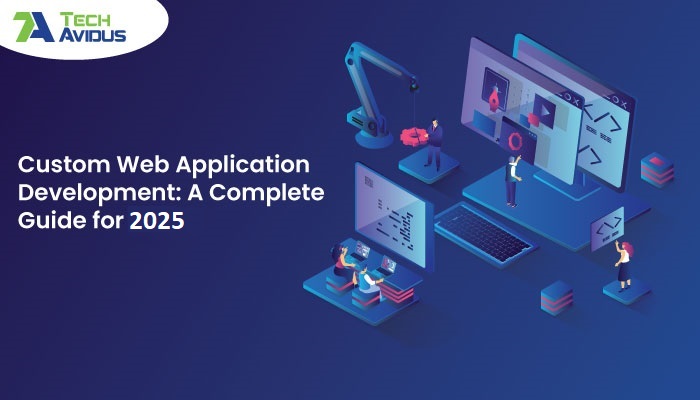
Nowadays, custom web applications pervade our online experiences and are quietly utilized by individuals globally. Developing a web application tailored to your brand essence and specific requirements can significantly elevate customer satisfaction, enriching their experience. Ultimately, a bespoke web app holds the key to unleashing your business's full potential on a global scale.
Working with a custom web application development company lets you have software designed and built specifically for your organization. That means that the software will be created to match your business processes, goals, and preferences.
Custom web application development involves creating tailored applications designed specifically for the needs of a business, rather than using off-the-shelf software. These apps are built with the goal of solving unique challenges, improving efficiency, and enhancing user experiences. Unlike generic software, custom web apps offer scalability, and flexibility, and can be fully integrated into an organization's existing systems.
As businesses continue to embrace digital transformation, the demand for custom web applications grows. These applications offer significant benefits that can propel your business forward.
Web applications have revolutionized how we interact with digital services. They encompass various functionalities, catering to diverse needs across industries. These applications leverage the internet to deliver services and experiences accessible through web browsers or specialized interfaces. Here’s an exploration of various types and notable examples:
E-commerce platforms are digital marketplaces where businesses and consumers interact to buy and sell goods and services online. They offer various products, from everyday items to specialized goods. Platforms like Amazon have revolutionized retail by providing many products, personalized recommendations, and convenient delivery options. On the other hand, eBay has established itself as a prominent auction and sales platform, allowing individuals and businesses to buy and sell new and used items through bidding or direct purchase.
Social media platforms are online spaces for social interaction, content sharing, and networking. They enable users to connect with friends, family, and communities worldwide. Facebook, one of the earliest and most influential social networks, offers various features for sharing posts, photos, and videos and communication through messaging and groups. Instagram, focused on visual content, allows users to share photos and short videos, emphasizing aesthetics and engagement through images.
CMS platforms empower users to create, manage, and publish digital content without extensive technical knowledge. WordPress, the most widely used CMS, offers flexibility, scalability, and an extensive library of plugins and themes, making website creation accessible to individuals and businesses. Joomla, another CMS, is known for its robustness and flexibility, making it suitable for building various websites, including e-commerce portals, social networking sites, and more.
Streaming services deliver online on-demand access to entertainment content, including movies, TV shows, music, and podcasts. Netflix, a pioneer in streaming, offers a vast library of films and series accessible on multiple devices with personalized recommendations. Spotify, a leading music streaming service, allows users to explore many songs, create playlists, and discover new music while offering free and premium subscription models.
These applications streamline communication, collaboration, and productivity within organizations. Google Workspace integrates various tools like Gmail, Google Drive, Docs, Sheets, and Meet, providing a comprehensive suite for email, document creation, storage, video conferencing, and more. Slack, a famous team communication platform, organizes conversations into channels, integrates with other tools, and facilitates real-time messaging, improving team collaboration and workflow efficiency.
Each of these types of web applications addresses specific user needs, leveraging technology to provide convenience, connectivity, and enhanced experiences in their respective domains.
Before starting the development process, define the goals, objectives, and technical requirements. Understanding what you want to achieve ensures that the final product aligns with your business needs.
Selecting the appropriate technologies is key to building a robust and scalable web application. Popular technologies for 2025 include:
A user-centric design is crucial. Focus on creating responsive, mobile-first layouts with a seamless UI/UX. Development should follow best practices like clean code, version control (Git), and agile methodology for better flexibility.
Testing ensures that the application works as intended. Automate testing where possible and use continuous integration/continuous deployment (CI/CD) pipelines to streamline the process.
Web application development is evolving rapidly. Here are some of the key trends to watch in 2025:
The cost of developing a custom web application ranges from $5,000 for small apps to over $100,000 for enterprise-level apps, depending on the complexity and features.
The best technologies include React.js, Angular, and Vue.js for the frontend, while Node.js, Django, and Ruby on Rails are popular for the backend. The choice depends on your project requirements.
Custom web applications offer unparalleled flexibility, scalability, and security. With the right planning, technology stack, and development practices, you can build an application that not only meets your needs but also helps grow your business in 2025 and beyond.
If you're ready to take your business to the next level with a custom web application, contact us today to start building your dream solution!
We have the most experienced Top 1% of Tech Talent Teams who can deliver superior technology solutions.
All Rights Reserved. Copyright © 2025 | TechAvidus